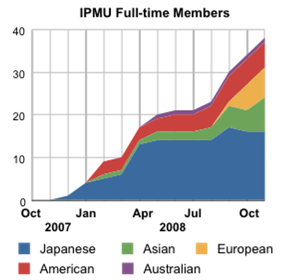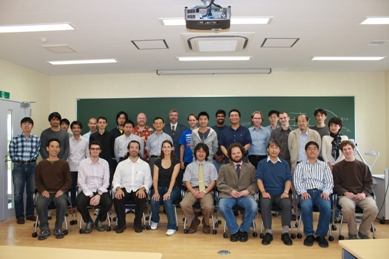Graphics and photos are available at:
http://www.ipmu.jp/press/20081002-press-image.html
Kashiwa, Japan - The Japanese government founded the Institute for the Physics and Mathematics of the Universe (IPMU) in 2007 with the mandate to become an international research institution open to the world. Now, one year after its launch on October 1, 2007, IPMU has marked a major milestone. 18 of IPMU's 34 full-time scientific members come from outside the country: Europe (6), North America (6), other Asian countries (5), and Australia (1) (see graphics)-an extraordinary degree of international collaboration in a Japanese research institute.
 Graphics: Ramp-up in the number of scientific members paid full-time by IPMU since its launch on Oct 1, 2007. Color-coding according to their nationalities.
Graphics: Ramp-up in the number of scientific members paid full-time by IPMU since its launch on Oct 1, 2007. Color-coding according to their nationalities.
A recent review by an international panel of distinguished scientists praised the successful launch. "The Institute for the Physics and Mathematics of the Universe, the University of Tokyo, has achieved remarkable visibility in a very short time. It has introduced innovative practices not seen elsewhere in Japan. ...IPMU is on its way to developing into a global research institute of a type unprecedented in Japan. It is totally new, and truly global. This has been made possible only by the distinct career background of its director. His impact and leadership have been noted worldwide." The panel included CERN Director General Robert Aymar, former PPARC Chief Executive Ian Halliday, and the late Yoji Totsuka, former KEK Director General.
"IPMU addresses the most basic questions about the universe," said Director Hitoshi Murayama, a theoretical physicist who came to IPMU from the University of California at Berkeley. "What is the universe made of? How did it begin, and what is its fate? What are the laws that govern it, and why do we exist in it? These are basic questions for all humanity, as reflected in the thoroughly international and interdisciplinary character of our institute."
The IPMU strategy calls for collaboration among mathematicians, theoretical physicists, experimental physicists, and astronomers. It intentionally avoids creating separate "departments" for each subfield, and its flat organization encourages interdisciplinary interactions regardless of rank. IPMU provides extensive help to non-Japanese researchers to complete necessary paperwork, find housing, and other logistics to settle down for a fruitful research life in Japan. The official language at the institute is English. It has about 15 new positions this year, open to the scientific community worldwide.
Hiroshi Komiyama, the President of the University of Tokyo, recognized the milestone in global collaboration. "Turning the University of Tokyo into a truly international research environment has been at the top of my priority list during my tenure as the President. I'm very pleased to see this dream realized in IPMU."
Assistant Professor Fuminobu Takahashi, who works on early universe cosmology and is the first full-time member of IPMU, says "Once inside IPMU, it is a cosmopolis. I feel big breakthroughs should happen here."
Mark Vagins, who joined the IPMU faculty from the University of California at Irvine, proposes to improve the Super-Kamiokande experiment to detect neutrinos from supernovae that exploded billions of years ago. Says Vagins: "This new Institute, with its explicitly interdisciplinary structure and mandate, strong governmental support, dynamic leadership, and world-class faculty and staff, is a remarkable place to work."
Michael Douglas, the first member of the new Simons Center for Geometry and Physics of the State University of New York at Stony Brook, has visited IPMU recently and agrees with its concept. "In recent years the fields of fundamental physics, cosmology and mathematics have been marked by intense and fruitful interaction. The founding of the IPMU is a very welcome development which is certain to further stimulate this interaction."
IPMU collaborates with National Astronomical Observatory of Japan, KEK, and Princeton University on an ambitious project to create the 3D map of invisible dark matter and determine the nature of dark energy. Michael Strauss from Princeton has visited IPMU to work on this HyperSuprimeCam project and remarked, "The open atmosphere and opportunities for interaction were wonderful. I look forward to future visits to exchange ideas with the broad range of superb scientists there."
Simon Dedeo from University of Chicago agreed during his recent visit, "This place reminds me of Princeton. With the new building up next year with its open design, it will be even better." He will join IPMU as a postdoc next spring.
- IPMU: http://www.ipmu.jp/
- WPI Program: http://www.jsps.go.jp/english/e-toplevel/
- WPI review result: http://www.jsps.go.jp/english/e-toplevel/08_followup.html
- IPMU: Presentation (25MB)
- Interactions News Wire #77-08
Fusae Miyazoe, Public Relations
Institute for the Physics and Mathematics of the Universe
University of Tokyo, 5-1-5 Kashiwa-no-ha
Kashiwa City, Chiba, Japan 277-8568
Tel: +81-4-7136-5977
FAX: +81-4-7136-4941
E-mail: press@ipmu.jp
 Photo: Researcher's group photo (2008/10/02)
Photo: Researcher's group photo (2008/10/02)






